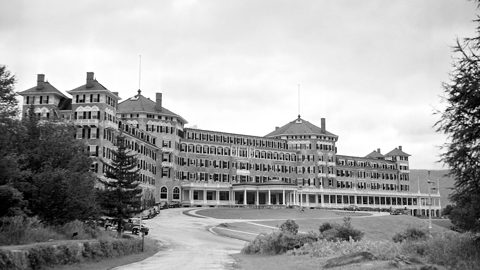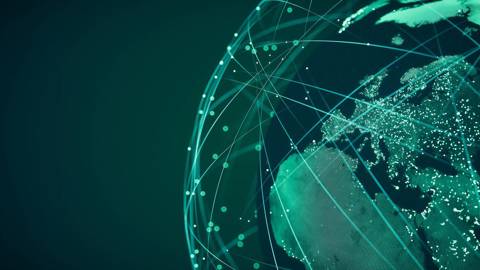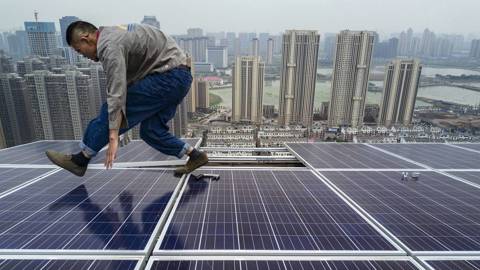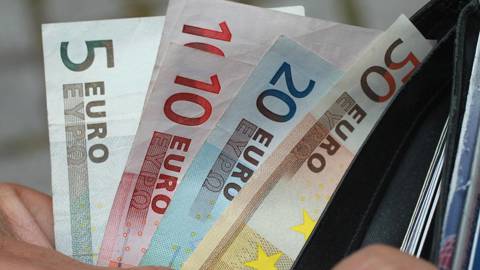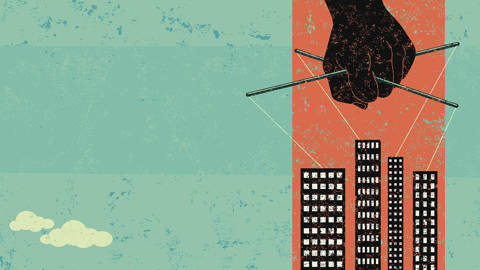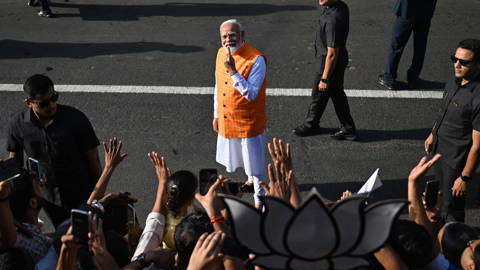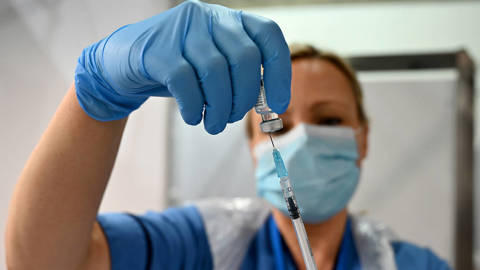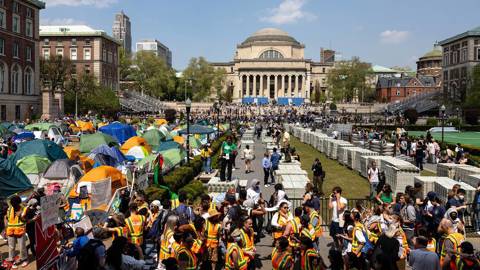Toward Bretton Woods 2.0?
In 1971, President Richard Nixon closed the gold window, effectively ushering in a new global monetary non-system with a single pillar: the US dollar. Fifty years later, that pillar is showing signs of strain. Can the world muster the cooperation needed to manage whatever comes next?
Listen and subscribe to all episodes from your favorite podcast app. Find Opinion Has It on Apple Podcasts, Google Podcasts, Acast, or via RSS Feed. Have a suggestion for an episode? Email us at podcasts@project-syndicate.org.
Transcript
Elmira Bayrasli: Welcome to Opinion Has It. I’m Elmira Bayrasli.
It was the summer of 1944. World War II was raging, and the global economy was in tatters. A peaceful and prosperous future characterized by global cooperation probably seemed like wishful thinking. And yet, at a secluded hotel in Bretton Woods, New Hampshire, delegates from around the world laid the groundwork for just that.
Archive Recording: At Bretton Woods, New Hampshire, delegates from 44 Allied and associate countries arrived for the opening of the United Nations Monetary and Financial Conference.
EB: The Bretton Woods conference gave rise to the International Monetary Fund and the International Bank for Reconstruction and Development, which would later become the World Bank.
Archive Recording: These meetings are designed to promote trade in the post-war world, and to create a foundation for lasting peace.
EB: It also established a fixed-exchange-rate system. All national currencies were valued in relation to the US dollar, which was convertible to gold at a fixed rate.
Archive Recording: When you think of a global currency, what is it that comes to your mind? Is it the US dollar because it accounts for almost 90% of the forex, about 62% of foreign reserves? It is called the petrodollar.
EB: But while Bretton Woods institutions went on to become pillars of the international order, the Bretton Woods exchange-rate system lasted only until 1971.
Archive Recording, US President Richard Nixon: I have directed Secretary Connally to suspend temporarily the convertibility of the dollar into gold or other reserve assets.
EB: Fifty years have passed since the so-called Nixon Shock, and the dollar is still the world’s leading reserve currency. But its position faces challenges from new instruments like digital currencies, and from new geopolitical arrangements.
Archive Recording: Concerns are growing that the Fed is endangering the dollar’s status as a global reserve currency.
Archive Recording: Billionaire investor Ray Dalio has warned that the conflict between the US and China could develop into a capital war, which would damage the dollar.
Archive Recording: Is there a real threat right now to the US dollar’s status as the world’s reserve currency?
Archive Recording, Ray Dalio: Yes, there is a threat. It’s an evolutionary type of process.
EB: Can the world come together to manage whatever monetary changes lie ahead?
Paola Subacchi: Hello.
EB: Hi, Paola.
Harold James: Hello, everyone.
EB: Hi, Harold. It’s so nice to meet you virtually.
HJ: Hello, Elmira.
EB: Here to help us answer this question are Paola Subacchi and Harold James. Paola is a professor of international economics at the University of London. Harold is a professor of history and international affairs at Princeton University. They join us from Europe.
So, I want to start by clarifying the outcomes of the Bretton Woods conference. The Bretton Woods institutions are often credited with helping to rebuild the European and Japanese economies after WWII. Paola, how did they contribute here?
PS: Well, the objective at the Bretton Woods conference in 1944 was to build the international monetary system for the new world economy – so, the economy and the new economic order that would happen after the war. The international monetary system was rebuilt around these institutions, the IMF and the World Bank. And so the objectives of the system were basically to create a robust framework for growth in the economy and to ensure full employment. And so that meant using policy tools in the countries that were members of the system to manage demand and to support growth and full employment.
There was another objective that was the balance-of-payments adjustment. That was very much in response of the issues and the problems that happened during the interwar – between the two wars, the First World War and Second World War – period. This adjustment was managed by the International Monetary Fund, and the other objective was the economic development. And that was very much a tool for efficient lending and that’s led to the institution or the World Bank. So, these two institutions are basically core and very much essential and existential to the Bretton Woods system.
EB: Of course, Bretton Woods didn’t only create institutions. It also established a fixed-exchange-rate system based on the US dollar’s convertibility to gold. In that sense, it was sort of an extension of the gold standard, which had collapsed during the interwar period. Harold, how did the Bretton Woods system improve upon the gold standard?
HJ: The gold standard had really just two alternatives. You stayed on a particular parity, or if you were buffeted by the winds of the international economy, you were pushed off it. The Bretton Woods system was designed by John Maynard Keynes and Harry Dexter White to be more flexible than that. So, it was a system of fixed, but adjustable, exchange rates.
But that actually constitutes a little bit of a problem because there’s a great deal of pressure on deficit countries to do something. So, deficit countries – you can tell by my accent, I’m originally from the UK, and the UK was in a terrible state through most of the 1960s, with constant rumors of devaluation. When you’re in that situation, you don’t have very much choice, and in the end, you’re pushed to devalue.
But on the other hand, the countries that were running surpluses didn’t have an equivalent pressure, and it becomes increasingly clear during the 1960s that there are big, big surpluses, in particular in two countries: West Germany – the Federal Republic of Germany – and Japan. And there was very little that could be done about that, so there’s a great deal of international jawboning on that pressure to revalue, but there’s no formal mechanism.
So, in the end, the answer to your question is that the Bretton Woods system resembled the gold standard more than it should’ve done.
EB: This link to the gold standard created another problem, as well.
Bretton Woods cemented the US dollar’s position as the world’s dominant currency. This was supposed to form the basis of a stable global financial system. And for a while, it did. For 26 years, the world was practically free of banking crises.
Archive Recording, Richard Debs, Bretton Woods Committee Member: The conference was a world-changing event. They managed to end decades of destruction and chaos and put the world on a new course aimed at international cooperation, global stability, peace, and prosperity, ultimately.
EB: But the system was fundamentally flawed. The dollar was needed as liquidity within the US economy. At the same time, it was needed as an asset held by foreign countries. And all of that needed to be backed by gold reserves. This became a serious problem in the early 1960s.
Archive Recording: This is a CBS news special report, Vietnam.
EB: US President Lyndon Johnson’s administration deepened America’s involvement in the Vietnam War, causing costs to soar.
Archive Recording: The American commitment to defend South Vietnam – it started small, but kept on growing from a few billion dollars of military aid, to a few hundred advisers, to more than half a million American troops.
Archive Recording: Four presidents have accepted and extended our commitment.
Archive Recording, US President Lyndon B. Johnson: To leave Vietnam to its fate would shake the confidence of all these people in the value of an American commitment.
EB: The Johnson administration also increased social spending as part of the Great Society initiative.
Archive Recording, US President Lyndon B. Johnson: The Great Society rests on abundance and liberty for all. It demands an end to poverty and racial injustice, to which we’re totally committed in our time.
EB: With America’s spending rising fast, the Bretton Woods system’s weaknesses could no longer be ignored.
PS: Well, the system was again on a sort of peg to gold, because obviously it was the dollar peg to the value of gold, as it was decided at Bretton Woods, and all the other currencies were pegged to the dollar. So, that was the mechanism implied.
At a certain point, the United States ran into a deficit of its current account, due to a number of reasons. One of them is the domestic spending. The other one is the Vietnam War and the objectives of the US foreign policy. At the same time, capital flows became more relevant in the system. So, and particularly in the early 1960s, there was the development of the offshore dollar market, which created liquidity in dollars and flows of capital.
At a certain point, people started to wonder whether the deficit in the current account of the United States would have pushed the US to adjust the value of the dollar, because by then, the value that was agreed was not often reflecting the economic fundamentals. So the way to adjust the system would have required countries with a surplus in their current account, particularly Germany, to adjust their exchange rates. And so to some extent, to cooperate and rebalance the system, and that was not possible for a number of reasons, including political reasons.
HJ: There’s a kind of systemic problem in the system, because every currency is defined in its relationship to the US dollar. But that means that the US dollar is actually in a way a prisoner. It can’t change its parity against itself. Now, it’s true that it could have changed the gold price. And there was some discussion, actually a long time before the crisis of the Bretton Woods system in the late 1950s, about devaluing the dollar against gold. But that actually wouldn’t have done anything to those imbalances that Paola was talking about because the exchange rates then would have been the same vis-à-vis the dollar for the yen or the Deutsche mark. It’s an odd thing because the dollar is the central currency, but that means also that the dollar is trapped by the Bretton Woods system. And there’s nothing really that the United States can do except something pretty explosive, which is exactly what Richard Nixon did on that memorable 15th of August, when he did the television address to the American people.
EB: So, picking up on the 15th of August in 1971, President Nixon closes the gold window. But Harold, you said that in doing so, he embraced economic nationalism. What was behind Nixon’s decision, and why was his approach so problematic?
HJ: Well, it was really acting like an elephant in the china shop. You know, if you take this story that I said – I think it’s correct – that the US is basically trapped by that, then it requires very radical action. But it’s action that upsets everybody. And it was very contentious. The very influential and very reputable chair of the Federal Reserve Board of Governors at the time, Arthur Burns, was bitterly opposed to this move, and he said again and again that it’s going to be a catastrophe – foreigners will retaliate; there won’t be trade protection – if the dollar is devalued. Then other countries will put up protective tariffs against the dollar, and you would be back in the world of the 1930s.
And in some ways there were trade conflicts in the 1970s, and there were very, very bitter international tensions in the 1970s. Nixon, you know, he promised in August 1971, when he talked to the American people, he talked about three things. He talked about creating more and better jobs. He talked about stopping the rise in the cost of living, because there was a little bit of inflation in the late 1960s. And he talked about protecting the dollar from the attacks of international financial speculators.
But all three of those actually became much worse as a result of the American action. And so in that sense, this was a move that really blew up, and it blew up the system, and it deeply destabilized the United States. Now, the United States was already in a bad situation. There’s the war in Vietnam that it can’t really extricate itself from, there’s the unrest of the late 1960s, the racial riots, the student protests. So, the United States is a society that’s on the brink. But what Nixon did, it didn’t do anything to improve the situation. And in that sense it’s a bold gamble. But it’s a gamble, in my view, that had great costs.
And really the system was only put together again in the late 1970s, when a new chair of the Federal Reserve comes in, Paul Volcker. What he did in 1979 was heroic, but it stabilized the United States. And in the end, it created a new kind of economy that was based – I think sometimes people called it the Volcker Economy, the Volcker Standard, rather than the kind of quasi gold standard that there was with the $35-an-ounce system of Bretton Woods. But between 1971 and 1978, the result was terrible for the United States.
EB: The Nixon Shock effectively blew up the Bretton Woods system of fixed exchange rates. It led to a revamp of the monetary system. But the Bretton Woods institutions, the IMF and the World Bank, lived on. It wasn’t smooth sailing, however.
PS: Of the two Bretton Woods institutions, the World Bank and the IMF, the latter was the one that felt the impact of the US decision of breaking the Bretton Woods system, because it was an institution that, for a number of years, lost its purpose, because the whole fashion and objectives of the IMF were to provide this balance-of-payment adjustment, to help provide liquidity to countries that needed to change the exchange rate, to rearrange the exchange rate, to provide this liquidity, to go through this process of adjustment. So, at that point, you know, the IMF was a bit left in limbo. And to some extent, it became again the lender of last resort in a very broad way. It was actually in later years where these two institutions started to change and become more engaged in global affairs. And I would say, in particular, after the [2008] global financial crisis and even more so after the breakout of the epidemic, the COVID epidemic last year.
EB: In Harold’s view, that initial disruption didn’t last quite so long. In fact, he thinks the IMF hit its stride after the collapse of the fixed-exchange-rate regime.
HJ: Yes, it’s a very odd phenomenon that the IMF in particular loses its raison d’etre in 1971. But actually it becomes more central and more powerful very quickly. In the 1960s, it had actually been rather impotent, because it’s very hard to tell countries to change their exchange rates. The Japanese don’t listen at all. The Germans only listen very intermittently. The French and the British don’t want to hear that their countries are running an overvalued currency. But in the 1970s, the IMF made itself – remade itself – as a manager of emergency support to countries that had been badly affected by the oil-price hike. So, it introduced new facilities, oil facilities, in the 1980s.
I think more centrally, it remade itself as a debt manager, and it became what it really has been since then, managing debt in problematic moments. That role came back again in a big way in 1998, in 1997-1998, in the Asian crisis. It came back again with regard to the European debt crisis after 2010. So, the IMF is completely different to the institution that Keynes and White envisaged in 1944. But intermittently, when there are debt crises, it’s more powerful than the International Monetary Fund ever had been in the classic Bretton Woods system.
EB: As Paola and Harold note, the Bretton Woods institutions played a significant role in responses to global crises, such as the crisis of 2008.
Archive Recording, US President George W. Bush: This is an extraordinary period for America’s economy. Over the past few weeks, many Americans have felt anxiety about their finances and their future. I understand their worry and their frustration.
Archive Recording, US President Barack Obama: The economic crisis we face is unlike any we’ve seen in our lifetime. It’s a crisis of falling confidence, and rising debt, and widely distributed risk, and narrowly concentrated reward.
EB: But in today’s changing global economy, the Bretton Woods institutions may not be fit for purpose.
PS: Obviously, these are the institutions that came out of Bretton Woods, where the United States is the main shareholder with the veto right. And obviously we live in a different world these days. There’s no longer the 1944 war world. And we have other countries that actually should be included, in particularly the big developing, big emerging-market economies that should be included in this governance in a more balanced way.
HJ: The issue, I think, today is, in one way, China or other big emerging markets. Are they going to work with this system or build up their alternative system? And many people see the One Belt, One Road initiative as a way of designing a quite separate view of globalization.
EB: So, it wasn’t just the IMF and the World Bank that survived the Nixon Shock, the US dollar’s primacy did, too. But, Harold, you’ve pointed out that doubts about the dollar have also been growing for a while now. When did these doubts emerge and what events fueled them?
HJ: So, in the 1970s, the dollar really does look as if it’s losing its position. And that’s actually one of the drivers of the process of European integration in 1978 and 1979. There’s an acute phase of dollar weakness. That’s when the dollar looks at its wobbliest. And that’s also the moment when the Europeans launched the European Monetary System, which is a kind of precursor of the monetary union. After 1979, that looks less impressive, in part because the US dollar really comes back, and that’s the Volcker Effect, and in part, because also private international capital movements are taking off. And so the dollar, instead of being a managed state currency, is now a currency that’s really managed by big, big financial houses, big banks. And it’s private dollars that are really blossoming in the 1970s and 1980s. So, the world is, in fact, more of a dollar-based system in the 1980s-90s than it was in the 1970s. The dollar is much more central. The dollar really survives.
But, you know, I think we’re, in some ways, at a moment when we’re looking now at a turning point in this development because the same kind of pressures that were there in the early 1970s are coming back: more American inflation, political pressure in the US to do both big fiscal action and keep monetary conditions easy. Now, we have a different sort of world in which other countries have currencies that are credible and stable. The Europeans do, the Chinese do. And there are also private providers of currencies. So, the options really look more now than they were in the 1970s. And now, I think, the search for replacement for the dollar is really on.
EB: As Harold points out, there’s been a boom in potential replacements for the dollar lately, especially with the rise of digital currencies.
Archive Recording: Over the past year, more and more countries have been gearing up to develop their national digital currencies. Now, China seems to be in the lead as it’s speeding up its digital yuan development.
Archive Recording: Residents in Beijing are now able to try out the new digital yuan in nearly 2000 stores in the capital.
Archive Recording: This is the first major economy to create its own digital currency.
Archive Recording: We can’t discuss digital currencies without mentioning Bitcoin, of course. It’s seen a resurgence of late, smashing through the $40,000 barrier for the first time last month, lifting the total value of the entire cryptocurrency market above $1 trillion.
EB: Harold has likened this to a new Nixon Shock. It might be destabilizing at first, but in the long run, the world may be better off.
HJ: You know, I think if you think about it, there are really just a relatively few number of currency regimes in history: the currencies backed by precious metal for thousands of years, and the Bretton Woods system has elements of that precious-metal-backed currency built into it, and the equivalence of the dollar at $35 an ounce. But that was something that the United States could change; it did change it unilaterally. There’s nothing illegal about what Richard Nixon did in 1971.
But what happened then was that you got a pure fiat currency, and it took time for monetary authorities, central banks to really learn how to deal with that. The 1970s and 80s were quite unstable, in part because of very different inflation experiences. In the 1980s, there’s the beginning of a convergence process that goes on for two decades. And by the 2000s, the world is moving to a low-inflation regime. And I think we will get the same kind of divergence – that we will have countries that inflate at different rates – and that’s going to generate volatility. But it may also generate really productive thinking, and it may generate a new wave of globalization. I’m actually quite optimistic about what may happen in the longer run, as the result of a change. But the short run is bound to be turbulent.
EB: But Paola isn’t convinced that the dollar is about to be dethroned.
PS: One of the reasons behind Bretton Woods and the need to set up an international monetary system that could work without creating imbalances was exactly to promote international trade and integration through trade. So, the dollar is the most liquid and the most usable currency in the world. It was true then; it is true now. Everywhere you go, you can use dollars. So, that is the thing, and with globalization, the value and the use of the dollar has increased. And so the dollar has actually become even more prominent than it used to be in the 1970s. Although we need to be careful not to confuse the volatility of the exchange rate – which for the dollar, however, as for all the advanced currencies, is pretty under control – with the liquidity then that currency provides.
So, at the moment, I do not see yet a currency that has the features, that presents the features, of the dollar, including the fact of being a safe haven at the time of crisis. So, we can see the fluctuation between gold, people investing in gold, and moving away from the dollars. But these are actually marginal movements on the whole.
The digital currency is an open question. I’m skeptical on some of those digital accounts, which are private. I think, at best, they are assets. If you think they are assets, and they are risky assets for some categories of investors. But they don’t present the features of currency issued by central banks of sovereign states. So, I’m not sure. We are in a transition, because the technology is very interesting. But my question is, are digital currencies, central bank digital currencies, fundamentally different from the physical currency issued by central banks? And if so, then possibly we see a new development in the system of payments. But I don’t see a fundamental change in the international monetary system as we know it.
EB: Harold, Paola has mentioned some of the dollar’s enduring advantages. These could certainly help it stand up to other currencies. But are there other factors that could make the world turn away from the dollar?
HJ: One of the things that is driving this move away from the dollar is the way in which the United States has used – I mean, in my opinion, actually mostly correctly – the dollar as an instrument of foreign policy. When it’s a question of isolating North Korea, it works pretty well. North Korea is a pretty small country and is not very well integrated in the international economy. When it’s the question of dealing with Iran, it’s more complicated. When it’s a question of imposing sanctions and putting measures against banks that do transactions with Russia or with individuals in Russia, you then really open up something. And the tensions, increasing tensions, with China, that’s really what’s driving this, that’s driving the search for alternatives. And it’s why China is really so actively thinking – has been thinking for a long time – about alternatives to the dollar world.
And so there’s a state reason for thinking about alternatives. But there are also private-sector providers. And, you know, one other feature of this is that yes, in countries that are on the whole very well-managed, central bank digital currencies will be successful. They will be successful in Sweden. They will be successful in the UK. But central bank digital currencies in many former Soviet republics in central Asia are not going to catch on, and that’s where the private market is going to be more important. And there’s really a proliferation of private providers. And that, as a historian, is familiar to me, because that’s what the world looked like in, for instance, in the late medieval period. There were lots of Italian city-states that provided their own systems. There were lots of banks that had their own bills of exchange, and they were equivalent, they were pegged to florins or ducats or British pounds. There’s a whole multiplicity of things. And it seems to me that there was actually an element of “back to the past” about this, that we’re reviving some of that multiplicity that really did exist in late medieval and early modern Europe.
PS: Absolutely. But even then, there were some key currencies that were much more acceptable than others. And then there was the gold content. That was what made the big difference. But I agree with you, Harold, there is a long-term transition here, and I entirely agree. And China’s trying to catch up. We might move into a multi-currency monetary system that China has been advocating for some time. We might move into a system with digital currencies that are issued by central banks, as well as the private sector. But I don’t think it’s happening now, in the short-term. It will take a while to go through this adjustment. And possibly, as you said, Harold, this transition would be very messy.
EB: Picking up on this idea of a messy transition, I want to end by looking at what role institutions might play in managing this process. Can the Bretton Woods institutions be reformed in a way that could help stabilize the new system? Or does the world need a new institutional framework, maybe with a bigger role for regional bodies?
PS: Well, Elmira, this is the hundred-million-dollars – and I say “dollars” – question, and there isn’t a clear answer. It could be, yes, we have arranged this institutional framework. Why don’t we continue to use it? But we need to go through a thorough reform of this system. And unfortunately, a thorough reform of the system has to go through the United States and through Congress, and this has proved very frustrating at the very least.
China is building some institutions that are regional, that are multilateral. I’m thinking about the Asian Infrastructure Investment Bank, but also the New Development Bank. So, it is all very messy. The key point here is that China has the resources to build another system, another institution or system. To some extent, some of the building blocks are already there. Is there a way to reconcile what we have already and what has been built in recent years? Ideally, I would say yes; I would love to say yes. Right now, these days, I’m not entirely sure whether this would be possible, because it looks like we are moving on two separate tracks. They may be parallel tracks, but there may not be a way to converge.
HJ: I think it’s also worth thinking about the fundamental question of this transition and monetary arrangements. Because the transition that we’ve been talking about was the transition from precious metal currencies to fiat currencies that are backed by the capacity of states to have fiscal capacity and to raise taxes.
There is, I think, an alternative, and that’s where the private currencies are really interesting. They can be backed by something, which is quite real, but is in a way unsubstantial. They’re going to be backed by data. So big, big operators – Google or Amazon or Baidu or Tencent – they have an enormous amount of data. That’s valuable. And that represents a kind of security that is different to either precious metals or to states raising money by taxation.
But when we think of that – like that – I think you can begin to see good implications and also frightening implications that when these large amounts of data are held by private institutions, private corporations, the tech giants, people are going to be worried about that privacy. People are going to be worried about whether they’re being manipulated by the data providers.
And so it does seem to me that if you really take that seriously, international institutions have a really important role, which is to manage data and make sure that data are publicly available, where it’s a public good. And so, we need something that is going to is going to be very quick, but also to protect people. And I see a much greater role for these international institutions in managing information flows, and providing information flows, and guaranteeing that this is not just left to the tech giants. So, this to me is the third kind of monetary transition from precious metals to governments and fiscal capacity to information.
EB: Thank you so much.
HJ: Thank you.
PS: Thank you. Thank you, Elmira.
EB: That was Paola Subacchi, a professor at the University of London, and Harold James, a professor at Princeton University.
And that’s it for this episode. Thanks for listening. We’d love to hear what you think. Please rate and review our podcast. Better yet, subscribe on your favorite listening app. You can also follow us on Twitter by searching for @prosyn. That’s P-R-O-S-Y-N. Until next time, I’m Elmira Bayrasli. Opinion Has It is produced and edited by Kasia Broussalian. Special thanks to Project Syndicate editors Whitney Arana and Jonathan Stein.
